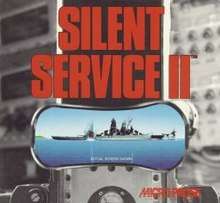Silent Service II
Silent Service II is a submarine simulation game developed and published by MicroProse for the PC DOS in 1990 and for the Amiga in 1991.[1] The game is a sequel to 1985's Silent Service, also set in the Pacific Ocean during World War II. Tommo purchased the rights to this game and digitally publishes it through its Retroism brand in 2015.[2]
| Silent Service II | |
|---|---|
 | |
| Developer(s) | MPS Labs |
| Publisher(s) | MicroProse |
| Designer(s) | Arnold Hendrick Roy B. Gibson |
| Programmer(s) | Roy B. Gibson |
| Artist(s) | Kim Biscoe |
| Writer(s) | Arnold Hendrick |
| Composer(s) | Jeffery L. Briggs |
| Series | Silent Service |
| Platform(s) | Amiga, Atari ST, MS-DOS |
| Release |
|
| Genre(s) | Submarine simulator |
| Mode(s) | Single-player |
Gameplay
Silent Service II allows the player to choose either single scenarios (training, a single historical battle, or a single random encounter war patrol) or an extended war career.[3] In the career mode, the player undertakes a number of consecutive patrols in the submarine, meeting other ships or convoys in unscripted encounters generated by the game. The player is able to select a home port and a patrol area on a map of the Pacific Ocean, and time acceleration allowed the submarine to move quickly to the chosen area. The length of each patrol is limited by the submarine's available fuel, but a typical war career can still take several hours of play time to complete. Common encounters involve the detection of a merchant ship or convoy, with the player determining whether and how to attack. On other occasions the player may face sudden detection by warships and be forced to act quickly to escape.
Several different viewpoints are available during play, including the bridge, the periscope - which could be used either submerged or surfaced - the navigation area displaying the area map, and internal status displays. Other ships are displayed as sprites in the bridge or periscope views, the game being capable of displaying graphics in 256 colours.
Reception
Computer Gaming World praised Silent Service II, citing its excellent graphics, "amazing" sound card audio and seven accurate submarine types. It concluded that the game "teaches historical lessons worthy of a graduate seminar in modern American history" while exciting as "a mammoth roller-coaster."[4] 1991 and 1993 surveys of strategy and war games in the same magazine gave it four and a half stars out of five.[5][6]
References
- "Silent Service II". Abandonia. Abandonia. Retrieved 22 March 2012.
- "Purchase Agreement between Atari, Inc. and Rebellion Developments, Stardock & Tommo" (PDF). BMC Group. 22 July 2013.
- "SILENT SERVICE II". Subsim.com. Subsim.com. Retrieved 22 March 2012.
- Wilson, Johnny L. (November 1990). ""Down The Throat" and "Up The Kilt" with MicroProse's Silent Service II". Computer Gaming World. p. 51. Retrieved 16 November 2013.
- Brooks, M. Evan (December 1991). "Computer Strategy and Wargames: The 1900-1950 Epoch / Part II (M-Z) of an Annotated Paiktography". Computer Gaming World. p. 126. Retrieved 18 November 2013.
- Brooks, M. Evan (October 1993). "Brooks' Book Of Wargames: 1900-1950, R-Z". Computer Gaming World. pp. 144–148. Retrieved 26 March 2016.